In a world where everyone uses the phrase “just Google it” multiple times a day, maintaining a positive online presence is more crucial than ever.
And one of the key elements that can impact your online reputation is the quality and legitimacy of your backlinks. Spam backlinks, in particular, can have a detrimental effect on your Google reputation and SEO efforts.
In this article, we’ll explore the dangers of spam backlinks, techniques to identify and analyze them, and advanced methods to remove them from your website.
Let’s dive in.
What are spam backlinks, and how do they impact your Google reputation?
Spam backlinks are links from low-quality or irrelevant websites created solely to manipulate search engine rankings.
These backlinks are often obtained through unethical practices such as link farms, paid link schemes, or automated software. While they may initially seem beneficial in boosting your website’s visibility, they can harm your Google reputation in the long run.
One of the primary ways spam backlinks impact your Google reputation is through their negative effect on your website’s SEO and PR. Google’s algorithm considers the quality and relevance of backlinks when determining search rankings.
If your website has a high number of spam backlinks, it can signal to Google that your site is engaging in manipulative tactics. This can result in a drop in search rankings or even a manual penalty from Google, severely impacting your online visibility.

Identifying and analyzing spam backlinks
The first step in defeating spam backlinks is to identify and analyze them. There are several tools available that can help you in this process.
Google Search Console is a valuable resource that provides a list of the backlinks pointing to your website.

Tools like Moz’s Open Site Explorer and Ahrefs can also provide insights into your backlink profile and help you identify spammy links. Here’s an inside look at Moz’s spam analysis:
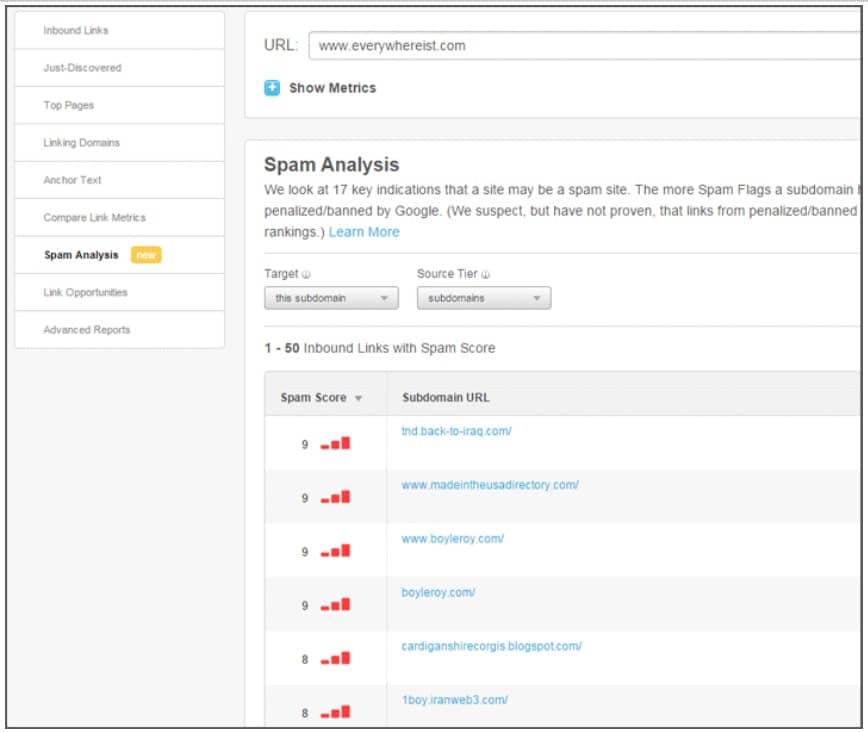
When analyzing spam backlinks, consider factors such as the domain authority (Moz), domain rating (Ahrefs), relevance, and anchor text of the linking website. If you are going to buy backlinks, you need to be very careful, as the reputation of your site depends on it.
Websites with high authority (50 or above) are more likely to provide legitimate backlinks, while websites with low authority (20 or below) are often associated with spam. Similarly, if the linking website is unrelated to your industry or uses irrelevant anchor text, it’s more likely a spam backlink (but not always).
Best practices for identifying spam backlinks:
- Analyze your backlink profile: Use a reliable backlink analysis tool to evaluate the quality of your backlinks. Look for suspicious patterns, such as a sudden increase in backlinks or many links from irrelevant websites.
- Check the source domain: Visit the websites that are linking to your site and assess their credibility. Look for websites with low domain authority, poor design, or questionable content. These are often indicators of spammy websites.
- Examine the anchor text: Pay attention to the anchor text used in the backlinks. If you notice excessive use of keywords or unrelated phrases, it may be a sign of spammy backlinks. Genuine backlinks typically use natural and relevant anchor text.
- Evaluate the context: Consider the context in which the backlinks are placed. If the links seem out of place, irrelevant, or hidden within the website’s content, they’re likely spam backlinks.
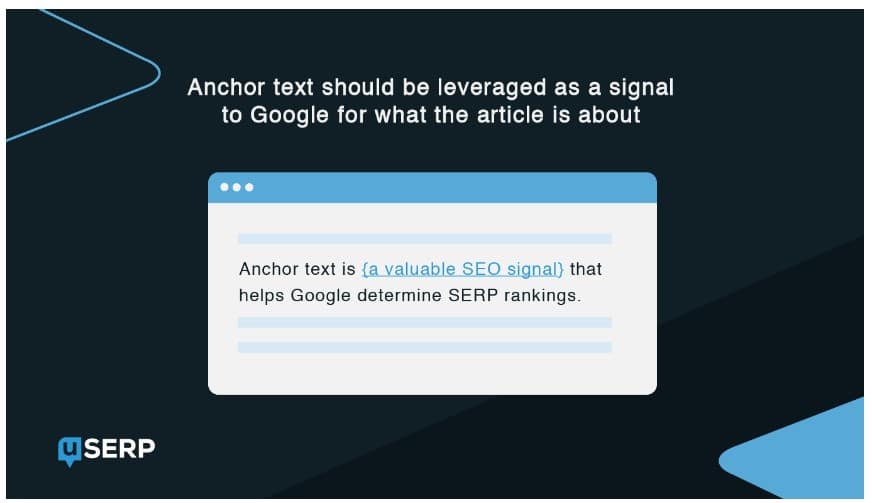
Techniques to eliminate spam backlinks
Once you have identified the spam backlinks pointing to your website, it’s time to eliminate them. There are two main techniques you can use: disavowing and manual removal.
Manual removal of spam backlinks
Manual removal involves reaching out to the webmasters of the linking websites and asking for the removal of any backlinks that you believe are spam. This process can be time-consuming and requires persistence. But it’s doable.
Start by identifying the contact information of the website owner or editor, which is usually available on their website. You can also use email finder tools like Hunter.
Craft a polite and professional email explaining the issue and requesting the backlink removal. Here’s a simple example:
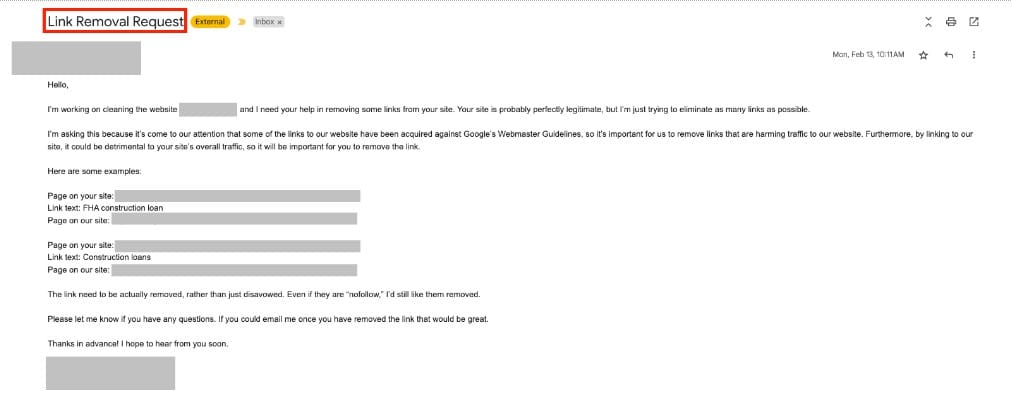
Screenshot by Brandon Lee
If your initial request is ignored or denied, follow up with a reminder email. Remember to keep a record of all communications for future reference.
And in some cases, you may have to resort to more assertive measures, such as contacting the hosting provider or using Google’s Disavow Tool.
Disavowing spam backlinks and using the Google Disavow Tool
Disavowing is a process where you inform Google that you don’t want certain backlinks to be considered when evaluating your website.
To disavow spam backlinks, you need to create a disavow file containing the URLs of the backlinks you want to block. Then, upload this file to the Google Disavow tool within Google Search Console.
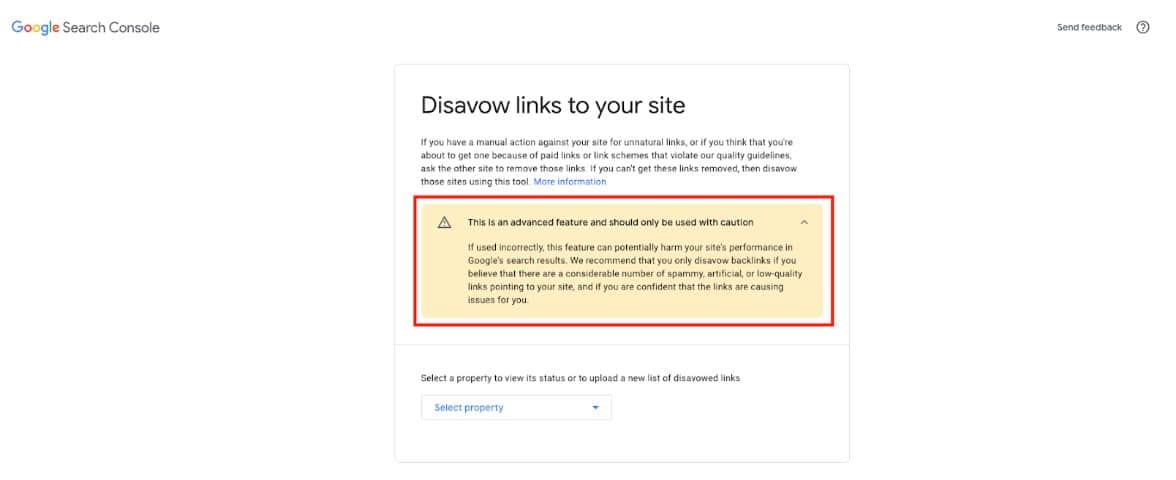
Screenshot by Brandon Lee
Take caution when disavowing links and make a genuine effort to remove them manually. Why? It can have unintended consequences if not done correctly. Even Google provides a warning before it lets you proceed.
That said, disavowing bad links should be your last resort when you can’t remove the spam backlinks through other means.
Don’t forget about regular backlink audits
Regular backlink audits play a crucial role in maintaining a clean and healthy link profile. By conducting periodic audits, you can identify and remove spam backlinks before they cause significant harm to your website.
Regular backlink audits are essential for a few reasons:
- Stay ahead of spam link attacks: Regular audits and social listening help you spot and remove spam backlinks as they appear, protecting your website’s link profile and avoiding penalties.
- Identify negative SEO attacks: Competitors or malicious entities may try to damage your website’s reputation by creating spam backlinks. Regular audits help you detect and neutralize these negative SEO attacks.
- Maintain search engine compliance: Search engines constantly update their algorithms and guidelines. Regular audits help you stay in line with these updates, and adhere to the latest standards.
Conduct regular backlink audits to proactively manage your link profile and safeguard your website’s online presence.
How to maintain a healthy backlink profile
To safeguard your reputation on Google and social media, you must continuously work towards building a healthy backlink profile.
In addition to monitoring via routine backline audits, actively work on building high-quality and relevant backlinks. Focus on creating valuable content that attracts natural backlinks from authoritative websites. Think about how-to guides, proprietary studies, and thought leadership content. Take the help of a professional by hiring content writers to get top-quality, best-performing content for your websites.
For instance, uSERP landed over 1,000 high-authority backlinks with one proprietary study about the state of backlinks for SEO in 2022.

Screenshot by Brandon Lee
You can also participate in guest blogging or podcasts to enhance your backlink profile. Or, if you prefer to outsource to the experts, you can always invest in link building services that do the heavy lifting for you (while also avoiding negative consequences).
When you focus on building high-quality backlinks, you can minimize the risk of spam backlinks in the future.
Key takeaways for managing a healthy link profile:
- Build high-quality backlinks: Focus on acquiring high-quality backlinks from reputable websites relevant to your niche.
- Monitor new backlinks: Regularly check new backlinks pointing to your website. This will allow you to identify any potential spam backlinks early on and take immediate action.
- Outsource to link building experts: Stay informed about the latest developments in SEO and link building strategies. By leaving this process up to the experts, you can follow search engine guidelines and avoid inadvertently attracting spam backlinks.
Preventing future spam backlinks
Instead of putting out a fire when bad backlinks appear, it’s always easier to prevent than remediate. With the right preventive measures, you can reduce the likelihood of spam backlinks harming your Google reputation from day one (read: the moment your website goes live).
Here are some techniques to consider:
- Regularly update your website’s security measures to protect against hacking attempts and unauthorized access. Spammers often target vulnerable websites to insert spam backlinks.
- Use rel=”nofollow” tags for user-generated content such as comments and forum posts.
- Be cautious when participating in link exchanges or buying links on Fiverr. Make sure that the websites you are partnering with have a reputable standing and are relevant to your industry.
- Regularly check your website’s analytics and search console data for any unusual spikes in backlinks, suspicious activity, or unnatural links.
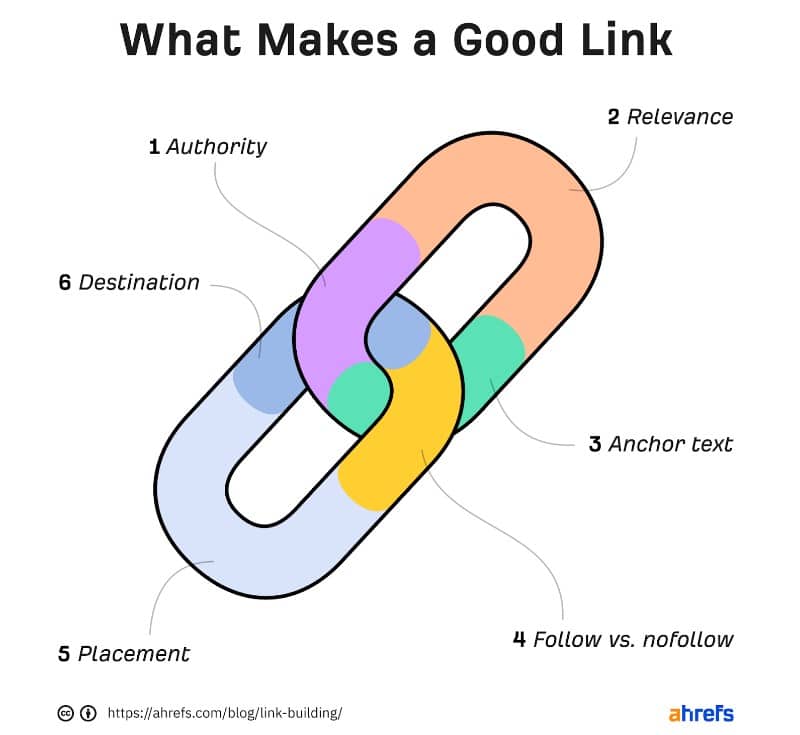
Tools and resources for managing spam backlinks
Dealing with spammy backlinks can be challenging and take weeks (or even months) to resolve. That’s thousands of missed opportunities for searching that you’re not appearing in.
Thankfully, several tools and resources are available to help you along the way. Here are some recommended tools and resources:
- Google Search Console: Use the Search Console’s “Links” section to check and analyze your website’s backlinks. This tool provides valuable insights into your link profile and can help you identify spam backlinks.
- Ahrefs: Ahrefs is a comprehensive SEO tool that offers backlink analysis features. Use Ahrefs to assess the quality of your backlinks and identify potential spam sources.
- Ranktracker: Ranktracker is another popular tool for backlink analysis. It provides detailed information about the quality and relevance of your backlinks, helping you avoid spam backlinks altogether.
- Webmaster forums and communities: Engage with webmaster forums and online communities to seek advice and learn from the experiences of others. These platforms can provide valuable insights and guidance on managing spam backlinks effectively.
Wrapping up
A lot of work goes into keeping your website’s link profile clean and pristine. Fortunately, following the strategies in this guide can help you automate the process and keep your SEO compliant with Google’s strict guidelines.
On top of that, keeping a healthy link profile is key for PR, mainly in helping journalists and publishers trust your domain during help-a-reporter-out (HARO) campaigns.
Ultimately, Google holds all webmasters responsible for creating and sharing valuable content. As long as you persistently do both, you’ll successfully maintain a clear Google reputation.
Say goodbye to toxic backlinks for good!








